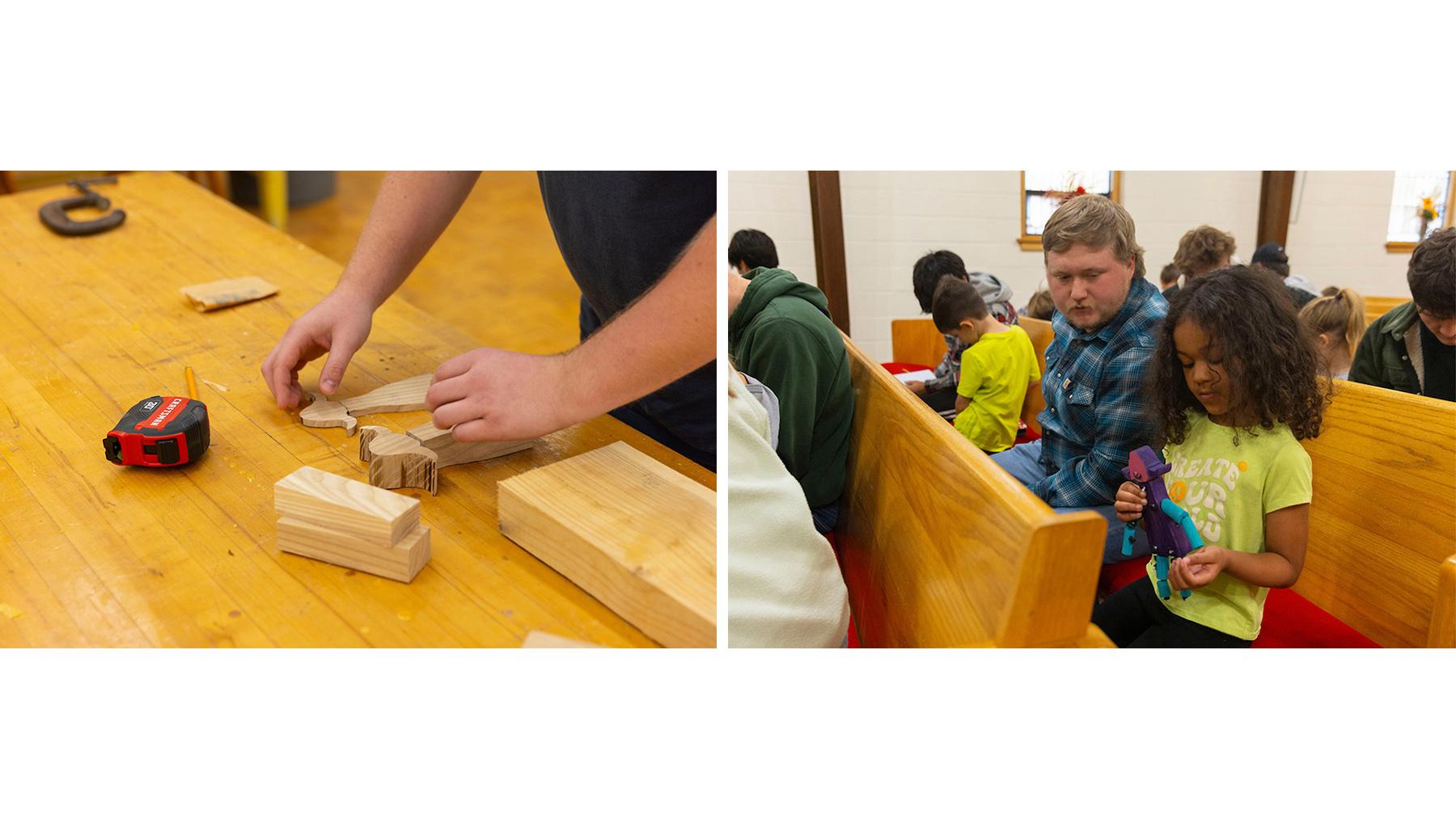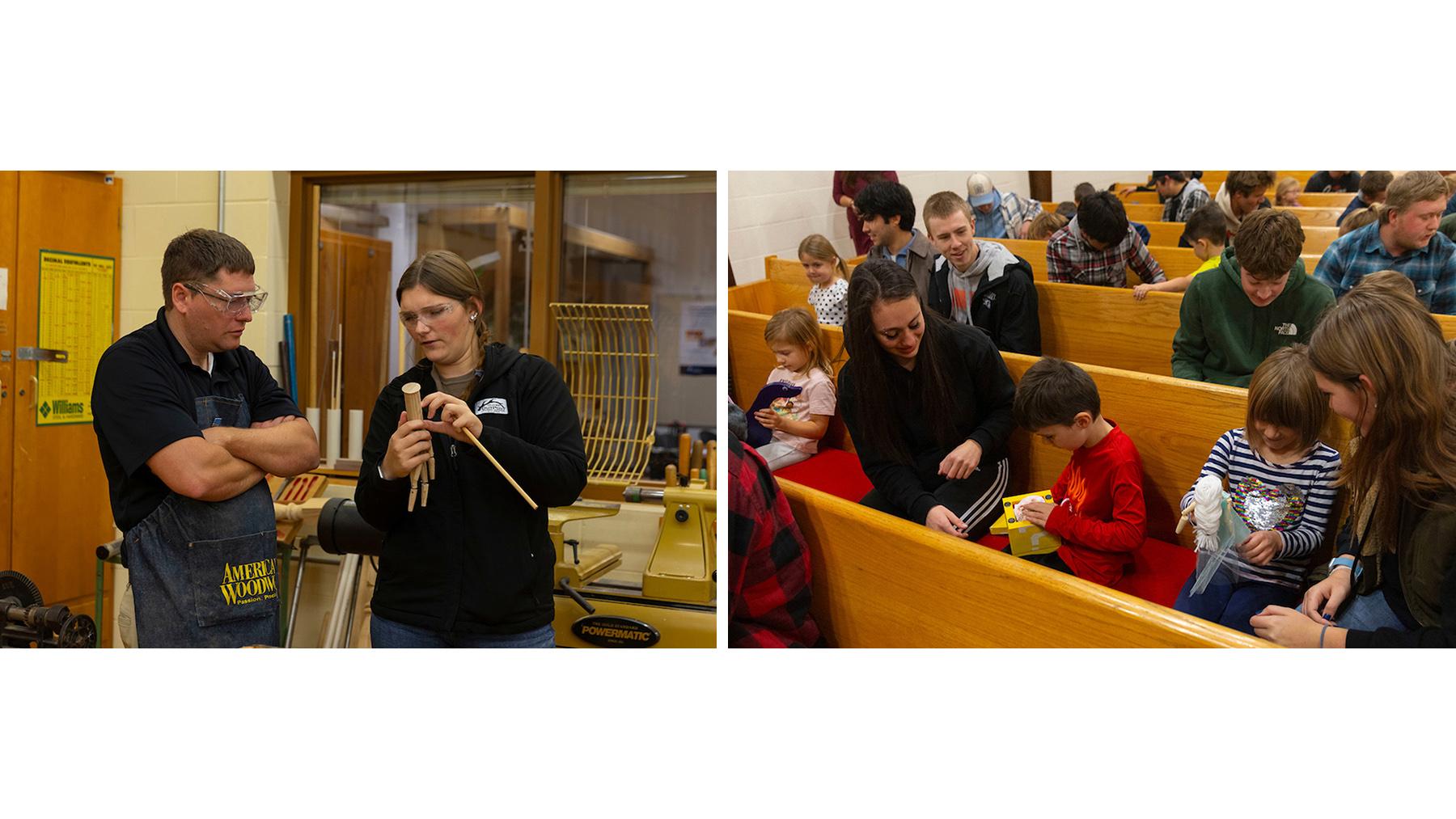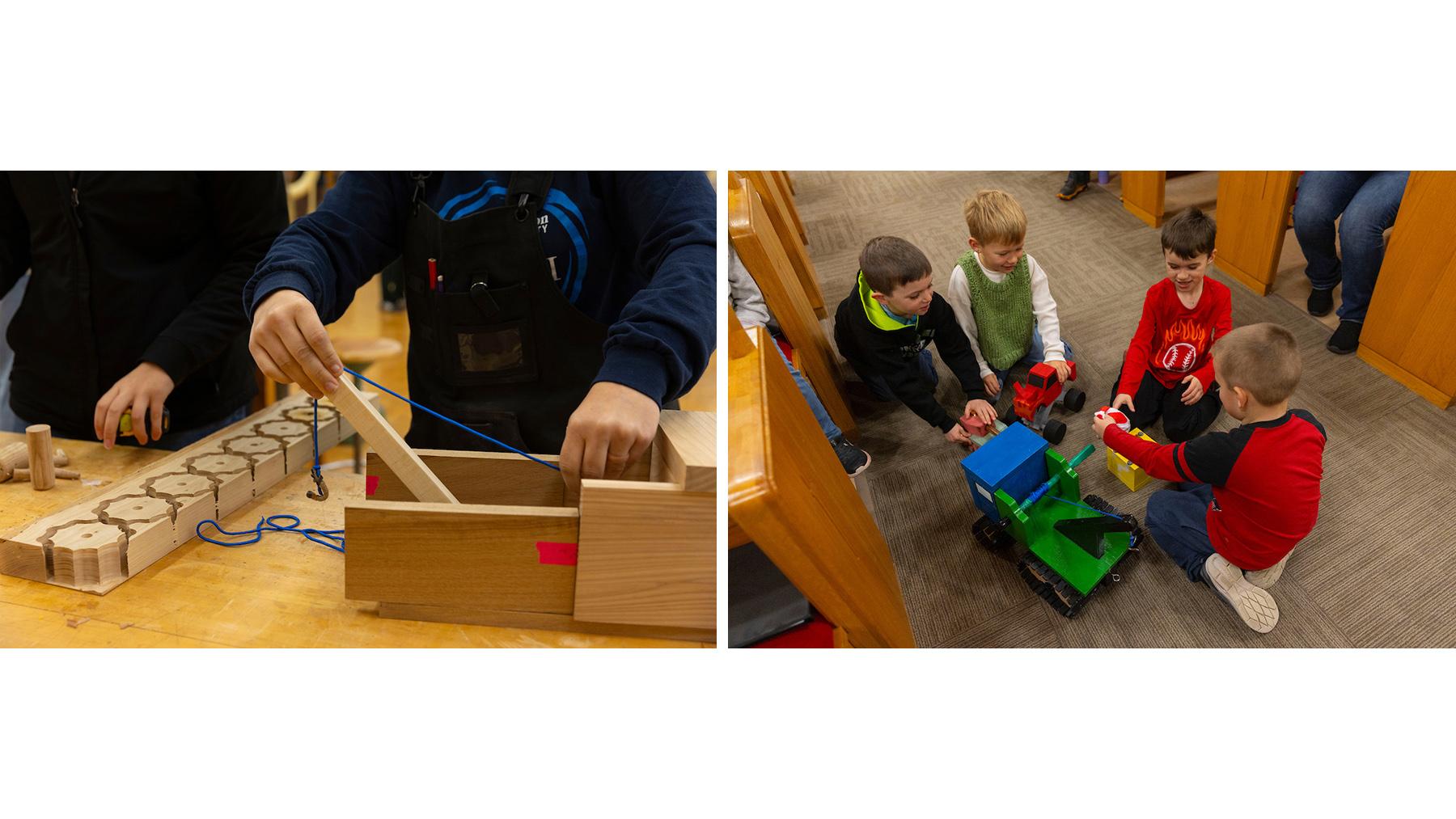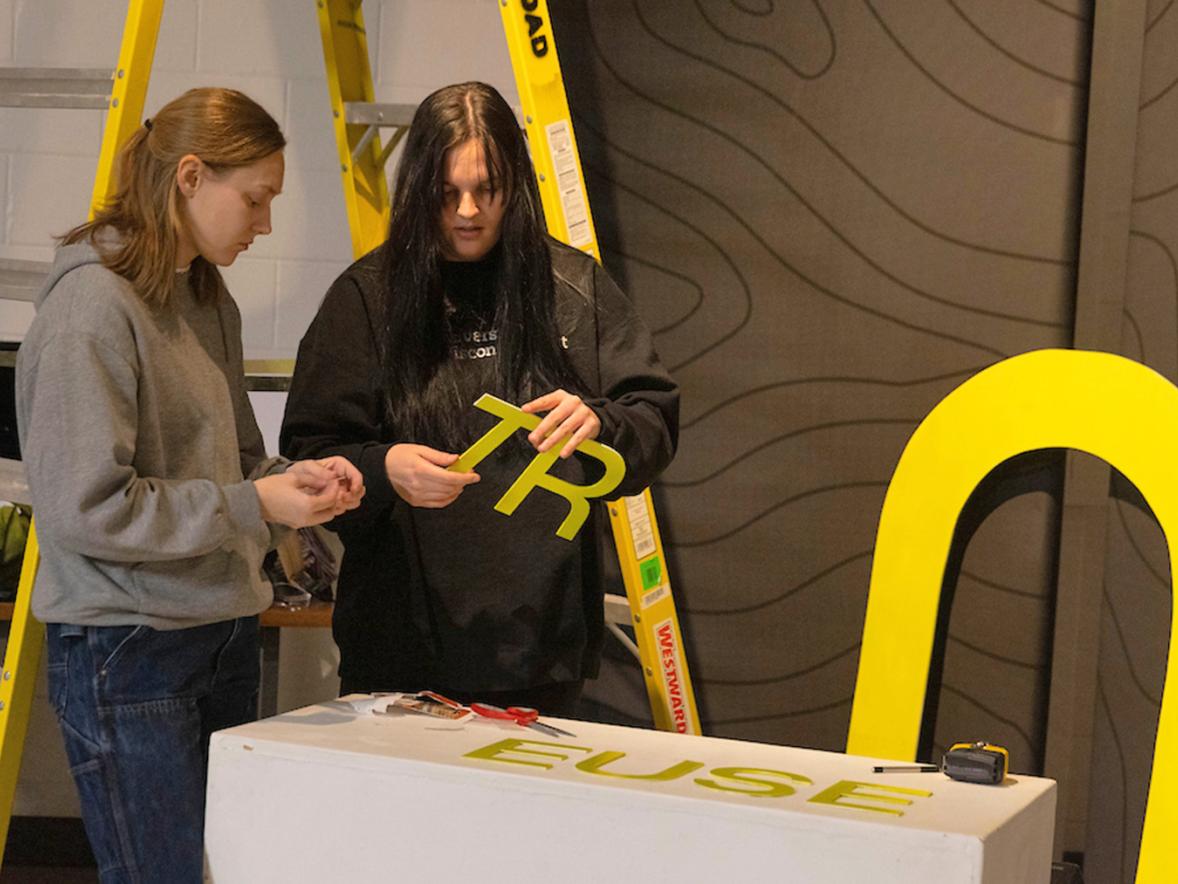On a warm October morning, 17 kindergartners from St. Paul’s School of Menomonie recently joined a class of UW-Stout students in Assistant Professor Kevin Dietsche’s Design for Industry course, unknowing of what excitement and imagination their day was about to bring.
As part of a toy design project, a user-centered design experience, teams of college and kindergarten students would brainstorm, draw and build a prototype with craft supplies of their ideal toys. They would then create rapid prototypes of the toys through artificial intelligence software and later build the toys in the university’s Woods Lab in Jarvis Hall Tech Wing, before delivering the final products to the children at their school.
See a selection of the toy building and gifting photos at the end of the story.
This was the start of the second year in a three-year, cross-disciplinary project supported by the G.A. Taft Manufacturing Engineering Endowed Professorship, which Dietsche was awarded in fall 2023. Continue reading to find out more about Timothy the Duck from the project’s first year.
In the Woods Lab classroom, Dietsche sat on the floor with the children, surrounded by his college students. He began by asking the children how to spell their names. They also spelled K-E-V-I-N together – a way for him to introduce himself to the young group and to open a new conversation.
“When you were coming to school this morning and you looked out the window, what did you see?” he asked.
The children listed several natural and mechanical objects: Leaves, clouds, bushes and farm combines.
“Were any of those things made, created or designed? Who made them?” he asked.
“People,” they tentatively answered.
“Right,” Dietsche nodded. “Everything we do here in this class is about design. And these students – these college students – they design and build things. They’re going to be engineers. Can you help us design today? You get to be a junior engineer and work with a college student friend to help design a toy,” he said.
Dozens of little eyebrows arched in anticipation, and with safety goggles on, they broke off in teams of twos and threes to gather around the lab tables.
Dietsche believes Design for Industry is a special class because of its cross-disciplinary nature. Students represent several degree programs, including mechanical engineering, manufacturing engineering, engineering technology, technology education and business administration.
Sparking creativity and building connections
The college and kindergarten friends began with a brainstorming Get to Know You exercise to help inspire what toys they might create and to connect with their young clients.
“I like that my students have the opportunity to meet the Stout students,” said Sandra Hemling, a kindergarten teacher at St Paul’s. “It sparks creativity, and they learn something new, even if they’ve never thought about engineering before. They can see the steps it takes to plan a design.
“I love how the kids are excited to come here. Even my shy ones are interacting. And they think, ‘Stout is somewhere I could go to school.’ It’s neat to see them thinking about the future,” she said.
Their toy ideas cover a range as vast as any 6-year-old’s imagination: a tank-copter (a combination of a tank and helicopter, of course); a magic spell casting kit; several animal species, such as horses, scorpions, cats and a bass in a bubble bath; dolls and action figures inspired by Nintendo and Disney characters; and a princess cat named Cakey.
As the kindergartners explain their grand ideas, the Design for Industry students make rough sketches of their young clients’ imagined toys. With small or large corrections here and there (Cakey, for instance, does not wear a dress but is covered in sprinkles), the rough sketches are complete.
The kindergartners then colored their ideas in every color of the rainbow, and using colored popsicle sticks, markers, crayons, glue, cardstock, pipe cleaners, Lego bricks, clay and more, the teams built low-fidelity prototypes of the toy concepts.
UW-Stout students team up with local children to design toys, give city ash trees new life
Continue ReadingThe last part of the morning’s activities was to produce rapid prototyping images of the imagined toys.
Dietsche’s students brought out their laptops, and using Adobe Firefly they typed in descriptions of the toys. The software generates four images based on the prompt, and just like the sketching exercise, the prompt can be edited to produce images to better match the children’s vision.
“Firefly is a tool to help make sure we know we are understanding what our clients want. It’s based on user-centered design. Instead of it taking weeks to ideate a client’s vision, we can do it in minutes, saving time, materials and money,” Dietsche said.
Within the next few weeks, his class will use 3D printing and solid modeling to help prototype parts for the toys. The kindergartners will return to UW-Stout to see the 3D prototypes.
Through the Taft Professorship, Dietsche has bought two new 3D printers for the Woods Lab.
Technology education in motion
The class includes a handful of technology education students who are working toward their K-12 licensure through the Wisconsin Department of Public Instruction.
Although graduates of the program will be teaching middle and high school students, technology education Program Director Mike Mills thinks the project is a good opportunity to involve elementary students in the engineering design process.
“The project also offers our students a glimpse into the cross-curriculum concepts of STEM (science, technology, engineering and math). It’s a good model for them to participate in with the younger students,” he said.
Future teachers Cadence Calkins, of Glen Flora, and Annika Schlueter, of Oconto, were helping their kindergarten friends to construct Cakey the Princess Cat out of Lego bricks and purple pipe cleaners and draw and color a Disney’s “Frozen” Elsa-style dress.
“It’s cool to see the developmental changes between the middle and high students we’ve worked with and these kindergartners. They think differently – that’s important to recognize,” Schlueter said. “Where these young kids see big details, like colors and shapes as being most important in the design process, the older kids tend to overthink things and look for perfection right away.”
Calkins enjoyed the creative freedom of working with her kindergarten friend and being able to experiment in design with the younger level.
Regarding perfection in design, she said, “As a teacher, students look up to you and so it’s good to let them know that you fail sometimes too. It’s one way to be relatable – to let them know that it’s OK not to be perfect.”
She gave an example of one of her own design failures. “On a 3D print project, my object printed way too small. I realized I was working in centimeters instead of inches. I learned to double-check my measurements,” she said.
Testing and failing are part of the learning process
In fall 2023, the project’s first semester, Dietsche’s class invited first-graders from St. Paul’s to collaborate on the same project, with an end goal of building mid- to high-fidelity prototypes of the imagined toys using ash tree lumber provided by the City of Menomonie’s Urban Forestry Board.
The finalized prototype was a pull-toy – Timothy the Duck, complete with wings and oval wheels, which gave it a waddling motion.
Timothy was designed by a team of mechanical engineering students: Josh Goodreid, Grace Goodreid, Ayden Veness, Deric McConnell, Shane Schauss and Vinny Bonofiglio. They are now in their Mechanical Engineering Capstone 2 course and are working to build a manufacturing cell, an automated machine, to produce multiple models of the toy duck.
The team presented its manufacturing cell prototype – constructed of wooden dowels and cardboard – to the kindergartners, showing them how it automatically assembles the pieces of the duck, including its body, wings, wheels and axle.
Together, the children and engineering team built a version of Timothy.
“My favorite part is that he waddles,” one child said, while another flapped his arms up and down and said, “My favorite part is the wings.”
The team explained how it went through several phases of testing Timothy before reaching a final model. In the first model, two wings were glued in place on either side of the duck’s body. But when testing to see if the wings were stable, one broke off when the team wheeled the pull-toy over a curb.
A modified second model, with a joint to strengthen each wing, broke as well.
“We failed again, but we learned again,” Josh said.
The team’s third design included a slotted groove in the duck’s back, where wings carved from a single piece of ash slid into place. After many more tests, the team decided this design worked the best.
Once the manufacturing cells are completed, Dietsche hopes to use the remaining ash lumber to make many Timothy toys to give back to kids in the community through various means, like Toys for Tots.
UW-Stout’s engineering and technology department offers six undergraduate degrees, including computer and electrical engineering, manufacturing engineering, mechanical engineering, plastics engineering, engineering technology and packaging, as well as four minors and a master’s in manufacturing engineering.
Technology education is offered through the School of Education, which is home to nine undergraduate degrees, five graduate degrees, certificates, certifications and online professional development courses.









